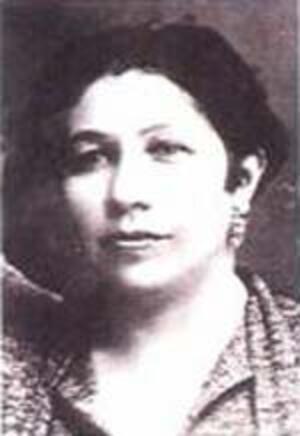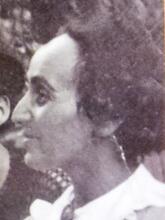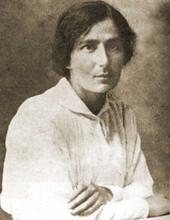Esther Raab
Esther Raab (1894–1981), Israel's first "native" woman poet, was born into one of the founding families of one of the first agricultural settlements in Eretz Israel. Born in Petah Tikvah, she later lived in Cairo, then Paris, finally settling in Tel Aviv, where her home became a center for writers and painters.
Institution: Kean University, New Jersey
Born in 1894 in Palestine, Esther Raab grew up in Petah Tikvah, where her religiously observant pioneer-farmer family was among the city’s founders. Although Raab’s formal education ended when she was a teenager, she was widely read in Hebrew, German, and French literature. Due to the difficult living conditions in Palestine, in 1921 Raab was sent to live with relatives in Egypt, where she married and pursued her literary interests, later returning to Tel Aviv. Raab played a major role in the entrance of women into the field of modern Hebrew poetry in the early 1920s. Her poetry includes detailed images from the world of nature, and she was the first modern woman Hebrew poet born in the Land of Israel, as well as a participant in the birthing of modern Hebrew.
Overview and Early Life
“I am under the thorn-bush / Nimble, menacing, / Laughing [at] its thorns / To greet you I straightened up.” This is the way Esther Raab presented herself to her first readers in 1922. At a time when Hebrew poetry by women was just beginning to be published, the opening lines of Ani tahat ha’atad (I am under the thorn-bush) introduced many of the themes and poetic devices that came to characterize Raab’s poetry and the way it was read. The landscape described here is bleached white under the sun at high noon. The sword-wielding female speaker portrays a murder/suicide that has inscribed her power on the stark landscape. The thorn-bush draws on both the biblical texts where the word appears: Jotham’s parable (Judges 9:14 and Psalm 58:10). A stark landscape, an unconventional female central character, a hint of a biblical inter-text, bold color, a linkage between eroticism and nature, and sparse, idiosyncratic punctuation are all elements which recur in Raab’s writing.
The Raab family, Esther’s grandfather Eliezer Raab, his brother and two sisters and his son Judah (1858–1948), emigrated to Palestine in 1876 from the Hungarian village of Szent István, settling in Jerusalem. There, Judah married the daughter of a wealthy widow. They had one son, Menahem. The marriage soon fell apart and Judah married Leah (neé Scheinberger). In 1878, the couple joined a group of settlers who founded Petah Tikvah. They had four children: Baruch (Ben Ezer, 1887–1960), Esther (April 15, 1894–September 1981), Elazar, and Benjamin.
A New Voice in Hebrew Poetry
Esther Raab was a Hebrew poet and memoirist who initially came to public notice due at least in part to factors of environment and circumstance. She had the distinction of being the first modern woman Hebrew poet born in the Land of Israel. Her poetry, much of which includes striking and detailed images from the world of nature, brought a new voice to Hebrew poetry. Her attachment to her landscape lacked the ambivalence that is often attributed to writers who came to the Land of Israel after they had already experienced the pull of their native lands. Near the end of her life she still remembered walking in the sand at night and feeling as if she “were the first and only creature within the infinite.” Her Hebrew, while not her first language, was precise, unclouded by the influence of other languages. A participant in the birthing of modern Hebrew, she remembered seeing each “word [as] new and shining with a wealth of colors like bird’s wings.” It was not an acquired language for her, but an innate vehicle of expression which grew and developed as she did.
In her memoirs and diaries, as well as in the many interviews she gave in the later part of her life, Raab describes growing up in Petah Tikvah, where her religiously observant pioneer-farmer family was among the founders. The relatively primitive conditions had an influence on the girl whose frequent bouts with malaria, school adventures, and early romances convey the portrait of a person who knows hardship and fights to overcome it. Her memoirs present a picture of life in the shadow of the eucalyptus tree outside the family home.
Raab enjoyed learning and resented having her schooling peremptorily cut off by her father when she was fifteen because a new principal decided that young men and women could study in the same classrooms. Nonetheless, her recollected childhood presents her close relationship with her father and her distance from her mother. In her strangely impersonal personal poem, LaAv (To the Father, 1929), written to commemorate the fiftieth anniversary of his settlement in Petah Tikvah, Raab praises her father’s hands for what they accomplished in shaping its landscape by sowing seeds, bending the grape vines so they develop new roots and planting eucalyptus trees. He was credited with plowing the first furrow in the settlement.
Personal Life and Literary Career
Although Raab’s formal education ended when she was a teenager, she was widely read in Hebrew, German, and French literature and later pursued some studies at the Sorbonne. She spent part of her late adolescence involved with the pioneers building the settlements of Deganyah and Nes Ziyyonah. Conditions in Palestine were so difficult for her family that in 1921 Esther Raab was sent to live with relatives in Egypt, where, in December, she married her cousin Isaac Green (Grün, b. 1888), who had professed his love for her eight years earlier. Green was a devoted husband who encouraged her literary interests, even supporting her visits to France, during which they corresponded in French. After about five years in Cairo, they built a large, red house in Tel-Aviv which served as a literary salon. The great disappointment of her marriage was her inability to have children, apparently due to her frequent bouts of malaria. The stillbirth of a son in 1924 was particularly painful. Unfortunately, Green died suddenly in January 1930, the year in which Raab’s first book, Kimshonim (Thistles), was published, dedicated “In memory of my friend Yitzhak Green.”
Green’s untimely death had a significant impact on Raab’s literary productivity. She wrote of his death: “I did not write, I did not publish for three years, I was frozen. [...] Ten years [which constituted my marriage] was the number of this life of friendship and serenity, and suddenly he went and I was as though I were not widowed—but orphaned” (In Cairo). Although Raab outlived Green by more than fifty years, they in many senses did not fulfill the promise of her younger years. A second marriage to the artist Arieh Allweil was short-lived (November 1, 1932–1935), leaving Raab both single and childless. Financial difficulties clouded the rest of her life, in which her poetic voice was often silenced for short or longer periods (e.g., from 1935 to 1947). She maintained close relationships with her extended family, one of whom, her nephew the writer Ehud Ben-Ezer, served as her literary executor.
The entrance of women into the field of modern Hebrew poetry was a phenomenon of the early 1920s, a revolution in which Raab played a major role. The literary establishment, still under the influence of Bialik, was not particularly open to the works of the four women who began publishing Hebrew poetry in this period: Elisheva, Rahel, Yokheved Bat-Miriam, and Esther Raab. Raab was in some ways the most isolated of the four, seeing herself as belonging to no literary school or generation.
Raab’s most significant book remains her first, Kimshonim, a collection of thirty-two poems, most of them short and untitled. Largely unrhymed and unmetered, these poems first appeared in run-on fashion: Poems do not start on a new page; each large page contains eleven or twelve lines, with the end of each poem indicated. Raab’s language and metaphors are forthright and uncompromising; her style, hers alone. Her attention to the details of the flora in Palestine yields a plethora of specific plants, many of them familiar to her from her youth. Her goal is not to present a landscape, but to present the emotions seething underneath the surface. The land is always changing, moving. The occasional biblical reference is but one of the indicators that within the lines of this secular poet there is a quest for ultimate connection in an almost religious sense.
Critical attention has focused largely on the poems in Kimshonim, leaving her later poetry in need of serious attention. It is as wide-ranging and varied in its themes and metaphors as the earlier work, though perhaps less connected to specifics of the landscape. Shirat Ishah (A Woman’s Song, 1969), one of her later poems, brings together her relationship to God, to the land, to poetry and to herself as a woman, exclaiming in its opening: “Praised are You Who have made me a woman—/ for I am land and adam [man].” Raab’s significance as a poet, as a woman, as a pioneer in many areas, continues to be revealed in her work through the depth and range of her voice.
Selected Works by Esther Raab
Kimshonim (Thistles). Tel Aviv: 1930.
Shirei Esther Raab (Poetry of Esther Raab). Tel Aviv: 1963.
PrayerTefillah Aharonah (A Final Prayer). Tel Aviv:1972.
Hemyat Shorashim (The Murmur of Roots). Tel Aviv: 1976.
Kol Ha-Shirim (Collected Poetry). Tel Aviv: 1994.
Kol Ha-Prozah (Collected Prose). Hod ha-Sharon, Israel: 2001.
Ben-Ezer, Ehud. Yamim shel La’anah u-Dvash (Days of Gall and Honey). Tel Aviv: 1998.
Luz, Zvi. Shirat Esther Raab: Monographiyah (The Poetry of Esther Raab: Monograph). Tel Aviv: 1997.






